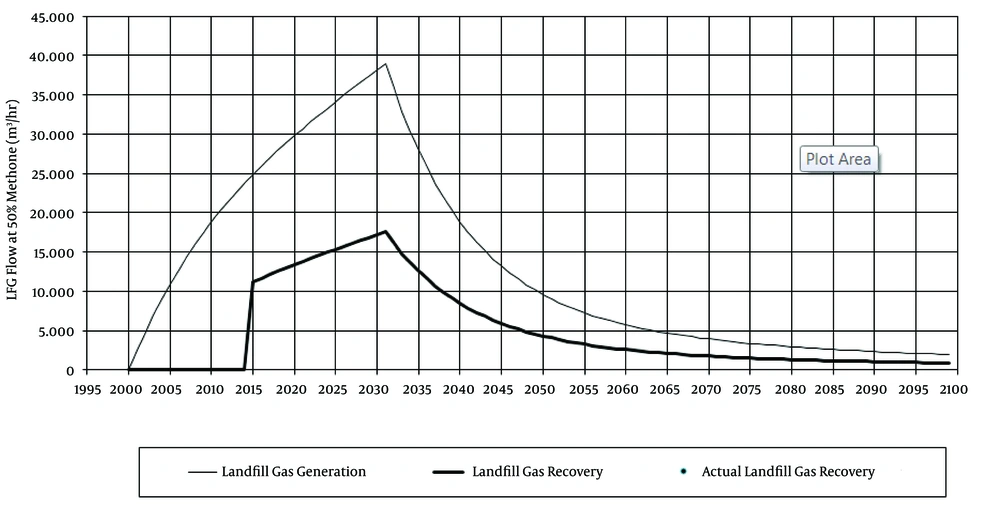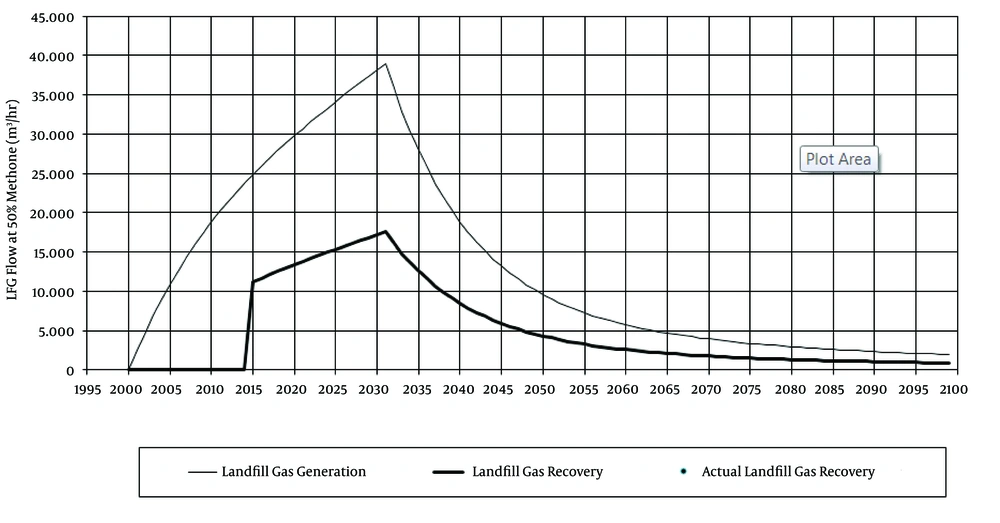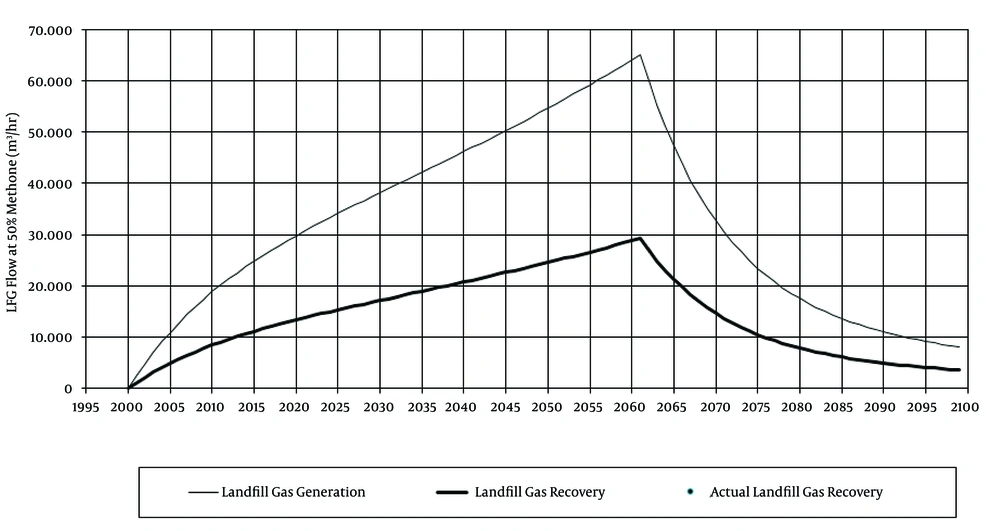1. Background
In recent years, municipal solid waste (MSW) has been one of the most important environmental concerns throughout regions of Iran. One of the MSW management strategies is landfilling. Burying waste in landfills creates offensive odors and potentially dangerous gases which are capable of moving through soil into nearby buildings. The most harmful gases generated in landfills are methane, carbon dioxide, ammonia and sulfides. Methane is flammable, while carbon dioxide is known to move into buildings and displace oxygen. In the 19th and much of the 20th century, it was common for Americans to bury their waste in landfills located near wetlands and bodies of water. The gas from these landfills leaked into the water and created health hazards for those living nearby. Some landfills even exploded as a result of the presence of flammable methane (1-4).
In 1993, the US Congress passed a law that required landfills to be lined with plastic to prevent leaks into the surrounding soil and groundwater. The law also required owners and managers of landfills to monitor gases emitted from the sites. Since then, many communities have reclaimed landfills, covering the garbage and converting the sites into parks and green areas. Despite the control measures in place to mitigate problems stemming from landfills, many Americans are calling for greater reduction in consumption and for increased reuse and recycling to avoid depositing so much into existing landfills. Such people hope for a day when the country will produce zero waste (1-4).
Burying waste produces methane gas as the waste decomposes, which has a number of uses in many industries and practices as well as in electricity generation through combustion. In general, burying waste is less efficient for power generation than the practice of burning the waste to power a turbine. Methane gas, as a byproduct of the waste burial process, is a valuable substance. Properly captured, it can be used as fuel for many different applications. It can also be used as a precursor in free radical chlorination, creating chloromethanes. It is not the ideal precursor for this process as methanol is, but it does serve the purpose. While methane is a valuable resource, burning garbage produces 10 times, as much energy as burying it and capturing its byproducts. The primary gain is that methane can be captured, moved and stored more readily than the energy produced by burning trash. The emissions produced by the two processes are actually roughly equivalent, meaning that there is no appreciable difference in the levels of pollution they engender. While burning is typically the better option, situational modifiers and factors may elevate the practice of burial and capture, according to the Environmental Protection Agency (EPA). These locations require site studies to identify the viability and implement techniques (1, 2, 5).
Landfilling is the most common way of MSW disposal in Iran. Because of the land available for burials and also the simplicity of this method of waste management, expected for at least two decades later, it would still be one of the main methods of waste management in Iran. MSW is made up of different organic and inorganic fractions. Typically, landfill gas (LFG) consists of 50% - 60 vol.% methane and 30% - 40 vol.% carbon dioxide as well as trace amounts of numerous chemical compounds such as aromatics, chlorinated organic compounds and sulfur compounds (1-3, 6).
What today’s society essentially needs the most is energy. The population of the world and therefore the demand of energy is growing (3, 7). Landfills are known as an important sources of methane production, which is considered as an important greenhouse gas (8, 9). Harnessing the power of LFG energy provides environmental and economic benefits to landfills, energy users, and the community. Furthermore, global warming can be accelerated by biogas escaping to the atmosphere. It has been estimated that the potential of a certain volume of methane is 23 times of CO2 at the same volume (10-12). In particular, LFG energy projects reduce the emissions of greenhouse gases that contribute to global climate changes (13, 14).
- Offsetting the use of non-renewable resources, such as coal, oil, and natural gas;
- Helping improve local air quality;
- Providing revenues for landfills and energy cost savings for users of LFG energy;
- Creating jobs and economic benefits for communities and businesses.
The amount of the produced gases based on waste composition, waste age, and the amount of total waste dumped are different (15-17). Estimating the amount of methane produced in the landfill site can help assess the potential use of landfill methane as an alternative source of energy, hazard control, and contribution to global climate changes (18). If uncontrolled LFG contributes to smog and global warming, health and safety concerns may be caused. LMOP is a voluntary assistance program which helps reduce methane emissions from landfills by encouraging the recovery and beneficial use of LFG as an energy resource.
This method reduces methane emissions by lowering the barriers and promoting the development of cost-effective and environmentally beneficial LFG energy projects. LFG is a natural decomposition of organic materials in MSW in anaerobic conditions (19, 20).
In this paper, LFG was considered in the landfill of Tehran using LMOP software. In addition, the relationship between the time of gas collection system operation and the volume of LFG production was evaluated.
Most of the existing models that predict greenhouse gas emission are based on advanced first-order decay models. First-order models presume a direct relation with waste carbon and exponential relation of the decomposition rate of released methane and time. For instance, Southwest Asia and North Africa (SWANA) model predicts gas emission (8, 21, 22).

Q, volume of released methane; M, mass of the produced waste; L0, potential gas emission; t, time; k, constant of the first-order decay model.
The coefficients of the first-order models generally overestimate the LFG emission, because they are extracted from a selected calibration method in a stable and ideal condition (23, 24).
In addition, LMOP Colombia model uses the first-order equations in all the analytical equations. LMOP Colombia model predicts the amount of methane release.

where the following factors are considered: Q, maximum estimated gas production rate of landfill (m3/year); I, annual increase of time; n, time gap between the landfill starting year and the year in which the calculation is done; j, 0.1 year increase in time; k, methane production rate (1/year); L0, potential methane production capacity (m3/mg); Mi, mass of the produced waste in the i-th year (mg); tij, age of part j of the waste disposed in year i; MCF, methane correction factor; F, adjustment factor for the possible landfill fire.
In this equation, k includes the moisture in landfill components, the availability of nutrients for methanogenic bacteria, pH, and the temperature. In this model, according to the climate and the composition of the waste, the value of k is suggested. L0 is changed depending on the amount of waste (25-27).
2. Objectives
In this study, the volume of the LFG of Tehran by LMOP software was calculated. In addition, the relationship between the time of gas collection system operation and the volume of LFG production was evaluated.
3. Materials and Methods
3.1. Introduction of Software
The US Environmental Protection Agency LMOP is a voluntary assistance program which helps reduce methane emissions from landfills by encouraging the recovery and beneficial use of LFG as an energy resource. LFG contains methane, a potent greenhouse gas, which can be captured and used to fuel power plants, manufacture facilities, vehicles, homes, etc. By joining LMOP, companies, state agencies, organizations, landfills, and communities gain access to a vast network of industry experts and practitioners, as well as to various technical and marketing resources which can help with the LFG energy project development. Available information and some presumptions are required to operate the software. MSW landfills are the third-largest source of methane emissions in the US generated by human activity, accounting for approximately 18.2% of these emissions in 2012. At the same time, methane emissions from landfills represent a lost opportunity to capture and use a significant energy resource. EPA launched LMOP to encourage the productive use of this resource as part of the US commitment to reduce greenhouse gas emissions under the United Nations framework convention on climate change.
3.2. Introduction of the Study Area
Tehran is located between the latitude of 35° and 36° north and the longitude of 50° east and is located in a semi-arid climate and experiences hot summers. Tehran is considered as the most populated province in Iran. Tehran is the capital of Iran with 664 km2 area and an approximate population of more than 10 million, which is a remarkable case study spot among Middle East cities. People of Tehran produce 7435 tons of waste every day (28). The Statistical Centre of Iran reported a population growth rate of 1.44 in 2013 (29). Furthermore, based on the data from Iran meteorological organization, the average annual rainfall in Tehran was 363.64 mm in 2013 (Figure 1) (30, 31).
3.3. Characteristics of the Studied Area
According to the abovementioned information, the following inputs were entered into the model:
- Opening date of the landfill site: 2000
- Closing date of the landfill site: 2030
- Waste production per day: 7000 ton (based on the 2008 data)
- Waste production growth rate: 1.44 (the same as Tehran population growth rate, because there was no valid source to find the volume of the waste during this period)
- Average rainfall: less than 500 mm/day (according to the climate of the area; ie, hot and dry climate)
- Based on the existing reports, no fire has occurred in the desired landfill site.
3.4. Characteristics of Waste in the Landfill
Table 1 shows the composition of solid waste collected from the landfill of Tehran in fall 2008 (28). MSW of Tehran is segregated manually into different physical components such as organic materials, plastic bags, paper, cardboard and paperboard, textile, glass, plastic, wood, construction and demolition (C and D), metals, other organic and other mineral materials. In this table, the volume of pet and tier are not mentioned, because these materials are not disposed this way and they are usually recycled and revered in solid waste management processes.
| Type of Waste | Fraction of the Total Weight, % |
|---|---|
| Organic materials | 67.8 |
| Plastic bags | 6.2 |
| Paper | 4.4 |
| Cardboard and paperboard | 3.7 |
| Textile | 3.4 |
| Glass | 2.4 |
| Plastics | 2.2 |
| Wood | 1.7 |
| Construction and demolition | 1.3 |
| Metals | 3.2 |
| Other organic materials | 2.5 |
| Other minerals | 1.2 |
Details of Waste Composition in Tehran
4. Results
Figure 2 shows the methane production in the years after the opening and closing the landfill. As seen, the peak in gas production happens after the landfill closure (2031) and the amount of production is 38997 m3/hour. Assuming that the gas collection system efficiency would be approximately 45% in 2015, Figure 2 shows the amount of LFG recovery collected.
Table 2 shows the LFG production rate (m3/hour), LFG recovery rate (m3/hour), maximum power generation capacity (MW), and reduction of methane emissions (tons CO2 eq/year) in each year.
| Year | Landfill Gas Production, m3/h | Landfill Gas Recovery, m3/h | Maximum Capacity of Energy, MW | Reduction of Methane Emissions, Tons CO2 eq/y |
|---|---|---|---|---|
| 2001 | 2537 | 0 | 0.0 | 0 |
| 2010 | 18838 | 0 | 0.0 | 0 |
| 2015 | 24864 | 11189 | 18.5 | 736 861 |
| 2020 | 29799 | 13409 | 22.2 | 883 111 |
| 2030 | 38200 | 17190 | 28.4 | 1,132,098 |
| 2031 | 38997 | 17549 | 29.0 | 1,155,705 |
| 2035 | 27906 | 12558 | 20.8 | 827,029 |
Calculated Values of Gas Production and Gas Recovery in the Landfill
According to the obtained results, it can be perceived that, from 2015 (when the system of gas collection was launched) to 2,100, about 501,482 m3 of methane can be extracted which is equivalent to 830 MW energy. Additionally, by setting the gas collection system up and consequently extracting gas from the landfill, the emission of carbon dioxide into the atmosphere will decrease by 33,026,459 ton, which is a significant amount in terms of global warming. In other words, if the systems for gas collection were not launched, this amount of CO2 would be emitted into the atmosphere and global warming would be exacerbated.
The model was run and solved based on the assumptions that the system would initially be launched and the gas of the landfill would be collected. Therefore, the procedure of gas retrieval would be as shown in Figure 3.
As expected, there was change in gas production; but, the retrieval was different. Based on the present results, it can be deduced that from 2000 to 2100, 558 m3/hour of methane would be extracted, which is equivalent to 2354 MW energy. Subsequently, the emission of 93,721,837 tons of CO2 would be prohibited.
5. Discussion
Burying waste produces methane gas as the waste decomposes, which has a number of uses in many industries and practices as well as in the generation of electricity through combustion. Modeling results showed that with the start of gas recovery in 2000 and 2015, power generation was 2354 and 830 MW, respectively. In fact, the 15-year difference in the gas extraction can make a 200% difference.
It was observed that 2.8 times more energy would be generated if the collecting system was initially installed. Moreover, if so, the equivalent CO2 would be reduced by 60,695,377 tons. Accordingly, the later the gas collection system is installed, the more the energy is lost and the further the pollutants are emitted. Therefore, immediate action is required to install the gas collection system if the loss and pollution are supposed to be reduced.


